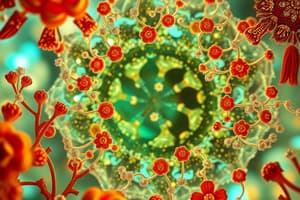Podcast
Questions and Answers
What is the total magnification achieved with a high power objective lens of 40X and an ocular lens of 10X?
What is the total magnification achieved with a high power objective lens of 40X and an ocular lens of 10X?
- 40X
- 100X
- 400X (correct)
- 1000X
Under which circumstances is immersion oil necessary when using a microscope?
Under which circumstances is immersion oil necessary when using a microscope?
- When using the scanning objective
- With lower power lenses
- When using high power and oil immersion lenses (correct)
- It is required for all objectives
What does the field of view refer to in microscopy?
What does the field of view refer to in microscopy?
- The area illuminated by the lamp
- The light intensity adjustment
- The area visible when looking through the eyepiece (correct)
- The total magnification applied
Which type of microscope is primarily used for observing the surfaces of large specimens and acquiring 3D information?
Which type of microscope is primarily used for observing the surfaces of large specimens and acquiring 3D information?
What is the purpose of adjusting the contrast in microscopy?
What is the purpose of adjusting the contrast in microscopy?
What should be done before switching to a higher power objective on a parfocal microscope?
What should be done before switching to a higher power objective on a parfocal microscope?
How is the size of a single cell calculated from the low-power field diameter?
How is the size of a single cell calculated from the low-power field diameter?
What is the relationship between the wavelength of light and resolution in microscopy?
What is the relationship between the wavelength of light and resolution in microscopy?
Which of the following statements about longitudinal and transverse sections is correct?
Which of the following statements about longitudinal and transverse sections is correct?
What is the limit of resolution for a microscope using visible light with a dry lens?
What is the limit of resolution for a microscope using visible light with a dry lens?
Which adjustment knob should be used for fine focusing after switching to high power?
Which adjustment knob should be used for fine focusing after switching to high power?
What is indicated by the 'parfocal' feature of light microscopes?
What is indicated by the 'parfocal' feature of light microscopes?
What is the primary purpose of a confocal microscope?
What is the primary purpose of a confocal microscope?
Which type of microscope is best suited for observing the surface of a specimen?
Which type of microscope is best suited for observing the surface of a specimen?
What should be the first step in focusing a microscope?
What should be the first step in focusing a microscope?
Which fluorescent stain binds specifically to adenine-thymine-rich regions in DNA?
Which fluorescent stain binds specifically to adenine-thymine-rich regions in DNA?
What is an essential rule to follow while using a microscope?
What is an essential rule to follow while using a microscope?
What is a limitation of electron microscopy compared to light microscopy?
What is a limitation of electron microscopy compared to light microscopy?
Which fluorescent protein emits red light?
Which fluorescent protein emits red light?
During microscope operation, what should be done to locate small objects on a slide?
During microscope operation, what should be done to locate small objects on a slide?
What kind of image does a transmission electron microscope (TEM) primarily produce?
What kind of image does a transmission electron microscope (TEM) primarily produce?
Which adjustment knob is used to achieve a sharper focus after the specimen is visible?
Which adjustment knob is used to achieve a sharper focus after the specimen is visible?
Flashcards are hidden until you start studying
Study Notes
Focusing the Microscope
- Parfocal microscopes allow the object to remain nearly in focus when switching between objective lenses.
- Always find the object using the low-power objective before switching to the high-power objective.
Field of View
- Field of view is the circular area visible through the microscope's eyepiece.
- The field of view decreases as magnification increases.
Measuring Cell Size
- Use a ruler to measure the diameter of the field of view in millimeters when using the low-power objective.
- Convert millimeters to micrometers.
- Divide the field of view diameter by the number of cells that fit across the diameter to calculate the size of a single cell.
Longitudinal vs. Cross Section
- A longitudinal section is a cut through the long axis of an organ.
- A transverse section (cross section) is a cut along a horizontal plane that divides the organ into superior and inferior parts.
Resolution
- The resolution of a lens refers to its ability to distinguish between two closely positioned objects.
- Shorter wavelengths of light provide higher resolution.
- The limit of resolution for a visible light microscope is ~300nm with air and ~200nm with oil immersion.
- Ultraviolet light microscopy can achieve ~100nm resolution due to its shorter wavelength.
Fluorescent Proteins & Stains
- Red fluorescent protein (RFP) and green fluorescent protein (GFP) allow for the visualization of specific proteins or structures within cells.
- DAPI is a fluorescent stain that binds to adenine-thymine rich regions in DNA.
Confocal Microscopes
- Laser scanning confocal microscopes (LSCM) use a laser to scan the specimen point by point, creating optical sections.
- A pinhole filter eliminates unwanted fluorescence from above and below the focal plane.
- Confocal microscopy allows for the imaging of structures at specific depths within intact biological specimens.
Electron Microscopes
- Electron microscopes use a beam of electrons to provide high magnification and resolution.
- They are capable of visualizing much smaller objects than light microscopes.
- Transmission electron microscopes (TEM) provide 2D images similar to a compound light microscope.
- Scanning electron microscopes (SEM) provide 3D images similar to a dissecting microscope.
- Extensive specimen preparation is required for electron microscopy, which can introduce artifacts.
Microscope Use
- Keep both eyes open while viewing through the microscope.
- Begin and end microscope use with the lowest power objective.
- Do not clean lenses with regular paper tissues.
- Do not tilt the microscope.
- Do not remove microscope parts.
- Locate small objects in the slide first by eye or under low power before switching to higher magnifications.
Focusing the Microscope
- Always start with the scanning power objective (4x).
- Lower the stage using the coarse adjustment knob.
- Place the slide on the stage, secure with a clip, and view through the eyepiece.
- Slowly raise the stage with the coarse adjustment knob to bring the object into view.
- Use the fine adjustment knob to sharpen the focus.
Microscope Parts and Function
- The microscope is composed of various parts that work together for image formation.
Lenses and Magnification
- The total magnification is calculated by multiplying the objective lens magnification by the ocular lens magnification.
Microscope Immersion Oil
- Immersion oil is used with higher magnification lenses to improve resolution by increasing the light passing through the specimen.
- Make sure the objective lens is an oil immersion lens before using immersion oil.
Stereomicroscope
- Stereomicroscopes are used to observe the surfaces of large specimens and provide 3D information.
- They are also used for micromanipulation and dissections.
- External light sources at different angles can improve contrast and depth perception.
- Stereomicroscopes are versatile due to the availability of various objectives and eyepieces.
Studying That Suits You
Use AI to generate personalized quizzes and flashcards to suit your learning preferences.



